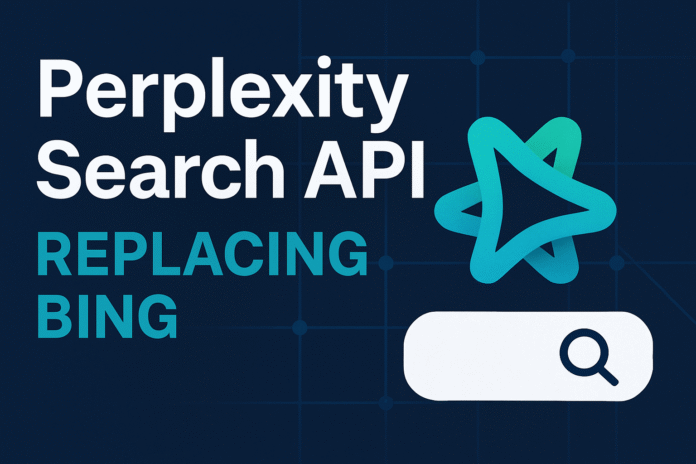For decades, search engines like Google and Bing have served humans navigating the web. However, AI systems (agents, chatbots, and reasoning pipelines) require a different approach: fast, structured, and relevant retrieval at scale.
Many AI tools have patched together ad-hoc pipelines or relied on Microsoft’s Bing Search APIs. With Bing retiring those APIs in August 2025, developers suddenly find a landmine under their infrastructure. Perplexity’s Search API is the most ambitious attempt yet to fill that void. Instead of a band-aid patch, they promise full infrastructure access: billions of pages, real-time updates, snippet-level answers, and robust ranking.
Behind the Scenes: How Perplexity Search API works
Per the official blog and Perplexity’s research:
- The API rides on the same infrastructure powering Perplexity’s public answer engine, bringing maturity and scale.
- The system indexes hundreds of billions of web pages.
- Documents are segmented into fine-grained spans, allowing the engine to return only the most relevant chunks.
- Retrieval employs a hybrid approach, combining keyword matching with semantic embeddings, to ensure both precision and understanding.
- Multi-stage reranking refines which spans are surfaced, reducing irrelevant noise.
- The output is structured: snippet, source, score, context, citations. This minimizes extra work for developers.
- They released an open-source benchmarking toolkit,
search_evals, which allows anyone to test latency, retrieval quality, or perform deep research tasks across APIs.
The claim: no more having to choose between “fast but shallow” and “deep but slow.”
Performance Claims (and How They Stack Up)
- Perplexity claims median latency of 358 ms, outpacing the “next best” by ~150 ms.
- 95th-percentile latency is held under 800 ms, ensuring even less common “slow” responses stay reasonable.
- In benchmarking against other commercial APIs, Perplexity claims to lead on both quality and speed across both single-step and deep research tasks.
- From Testing Catalog: pricing is $5 per 1,000 requests (with no additional token fees for Search API), and features include regional filters, multi-query batching, and academic mode.
These numbers are compelling, but of course they are self-reported or benchmarked in controlled environments. Independent validation (via search_evals or third-party tests) will matter.
Risks & Challenges for Perplexity Search API
From ongoing legal battles to issues with data copyright, source, and quality, perplexity search AI faces numerous challenges in becoming a viable AI search engine.
Legal & Copyright Pressure
Perplexity is embroiled in legal battles:
- NYT sent a cease-and-desist, accusing Perplexity of using its content without permission.
- More recently, Britannica and Merriam-Webster sued, alleging the “answer engine” copies and misattributes content.
- The company says it indexes pages rather than training on them and is experimenting with revenue-sharing for publishers.
The outcome of these cases will help define what “legal indexing” means in the AI era.
Bias, Source Quality, and Overconfidence
Indexing at scale doesn’t guarantee reliability.
- The audit “Generative AI Search Engines as ‘Arbiters of Public Knowledge” found bias in source selection and uneven quality across topics.
- The “Perplexity Trap” indicates PLM-based retrievers may over-reward low-perplexity (i.e. more predictable) text, which can skew ranking in favor of simpler, formulaic content—even if less substantive.
Agents integrating the API will need to treat results critically, weigh confidence, and possibly cross-check.
Monopoly Risk & Infrastructure Concentration
If many AI systems wind up depending on Perplexity’s API, it becomes a chokepoint. Outages, policy changes, or bias in its data could ripple widely. Robust fallback strategies and competing APIs are essential for resilience.
Adoption & Migration Hurdles
Many AI systems already use internal or hybrid retrieval pipelines. Switching to an external API involves cost, trust, latency risk, and potential lock-in. Convincing organizations to migrate is nontrivial.
Error Propagation & Hallucinations
A retrieval mistake (wrong span, misranking) can propagate downstream into hallucinations or misinterpretations by LLMs. The margin for error is thin; safeguards are essential (confidence thresholds, query fallback, human oversight).
What to Watch & What This Could Enable
- Independent Benchmarks: The community will scrutinise
search_evalsresults. If external evaluations confirm Perplexity’s claims, adoption will accelerate. - Litigation Outcomes: Court rulings about indexing vs training, attribution, and compensation will set norms for what APIs can do.
- Competing Search APIs: To avoid centralisation risk, alternatives (open or proprietary) will need to emerge—maybe modular search protocols or federated indices.
- Advanced Agents: This kind of API enables more capable agents—ones that can interleave reasoning, retrieval, verification, and planning more cohesively.
- Economic Models for Content: How publishers are compensated (or not) will be a major battleground. Transparent, sustainable models are needed to avoid destruction of the content ecosystem.
Conclusion
The Perplexity Search API is more than a product launch; it’s an inflexion point in how AI systems interface with the world’s information. If the promises hold true—enabling rich, fast, and structured retrieval at scale—it could become foundational infrastructure for the next decade of AI.
But engineering promise alone isn’t enough. Legal, ethical, competitive, and adoption hurdles loom large. Whether Perplexity becomes the “Google of AI search” or just one of many contestants in a crowded retrieval arena depends on execution and how the broader ecosystem responds.
In a world where knowledge is power, who controls the pipe to that knowledge is the question we should be watching closely.

